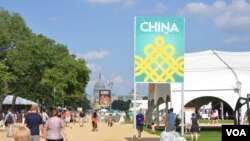A curious child waddles up to the man holding a brightly colored kite. She asks him a question but he can only sheepishly smile to show that he does not understand her language. She nonetheless smiles back broadly as he lets her hold the paper kite. Though they cannot speak with each other, they’ve just experienced what the Smithsonian Folklife Festival in Washington, D.C., is all about: cultural exchange.
Between the classic American landmarks, the Capitol building and the Washington Monument lay China and Kenya -- or, rather, a small taste of the culture and traditions that these countries have to offer. They're this year's featured countries for the annual festival, which opened last weekend on the National Mall and resumes July 2-6.
The festival attracts almost one million visitors each year, who come to see an array of performers and artisans.
Outreach to China
"We're bringing about 120 people from China - musicians, dancers, calligraphers, kite makers, embroiderers, batik dyers - to demonstrate and to share their traditions with our public," said Jim Deutsch, the Smithsonian's program curator.
Together, they provide a diverse picture of China's landscape.
Deutsch and his colleagues have been collaborating with the China Arts and Entertainment Group, the production arm of the Chinese Ministry of Culture. A performer from the Chinese production group, who gave his name as Zhao, said the Chinese artists have come from all over China.
"They are from 15 different provinces in China and they will present eight different kinds of performance programs and 16 handcraft programs," Zhao said. "Now, for example, you can see the New Year springs and the doll sculpture, and for the performance there are groups, companies from the Wu Opera and also the Inner Mongolian song."
Participants and performances are scattered throughout the festival for visitors to discover as they journey through the various tents. There are musical performances in the Moonrise Pavilion, cooking demonstrations in the Five Spice tent, and discussions in the Tea House Commons stage. There are also Chinese language lessons and martial arts demonstrations, all organized so visitors can interact and learn from the Chinese participants.
Hands-on experience
One hugely popular tent offers visitors the chance to see demonstrations of traditional Chinese calligraphy -- and to get samples of their names translated in caligraphy as free souvenirs. Visitors crowd the table and compete to peer closely at the scrolls.
One day last week, caligraphy artist Jong Wang sat calmly amid the clamor, churning out name after name. Originally from Taiwan but now living in metropolitan Washington, D.C., Wang said he came to the festival to demonstrate not only the artistic aspect but also the meditative qualities of calligraphy.
“If you can control the brush, then you are able to write," Wang said while taking a break between workshop shifts. "This practice is over a thousand years old. It takes a lot of control, just like our daily life. For example, when you move the brush backwards to the opposite position to where you want to go, it takes discipline.
"It is like how we must think of things in our mind first. Prepare and then stop,” she said.
Desiree Sisitka, making her second visit to the Folklife Festival, called the Chinese exhibits and demonstrations "lovely."
“We just walked around and looked at crafts over there and the textiles and the clay and it was beautiful," she said.
Cultural preservation
As its title suggests, "China: Tradition and the Art of Living," the festival also aims to demonstrate how the featured countries preserve traditions.
Curator Deutsch said cultural preservation has become a focus in the face of China's rapidly changing landscape.
He initially visited the country in 2006, then returned in 2012 and 2013.
"What impressed me the most was the transformation," Deutsch said. "China is transforming more rapidly than anyone had ever imagined. And that's one of the things we're incorporating into this program: How is China maintaining its cultural heritage and maintaining its traditions in the face of this massive transformation? China is a global phenomenon, the 21st century may be the century of China."
The festival, Deutsch said, intends to help people understand "the global phenomenon that is China."





